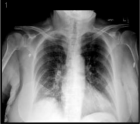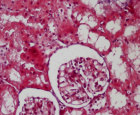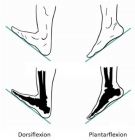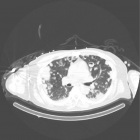Abstract
Retrospective Study
Detecting Pneumothorax on Chest Radiograph Using Segmentation with Deep Learning
Joshua Friedman and Peter Brotchie
Published: 09 July, 2024 | Volume 8 - Issue 1 | Pages: 032-038
Introduction: Pneumothorax is a life-threatening condition that requires prompt recognition and therapy to prevent deterioration. Radiologist workload often precludes rapid assessment of the usual diagnostic modality, the chest radiograph, particularly after hours. The aim was to develop a deep learning model using a segmentation-based Deep Convolutional Neural Network (DCNN) to detect pneumothorax on chest radiographs to provide rapid and accurate pneumothorax diagnosis.
Methods: This is a retrospective study of spontaneous pneumothorax at a single center, containing 130 positive and 70 negative radiographs. Subsequent manual contour mapping was performed to draw a mask of the pneumothorax. These image pairs were used to train a DCNN model (a modified AlexNet) after pretraining on the ImageNet dataset.
Results: The DCNN achieved an accuracy of 0.83, with sensitivity of 98.1%, and specificity of 68.5%.
Conclusion: This segmentation-based DCNN accuracy is comparable to previous categorization-based CDNN models, despite using a smaller sample size for training, while including the benefits of visual representation for clinician feedback. Segmentation-based DCNNs show promise in the development of accurate and clinically useful models for medical imaging.
Read Full Article HTML DOI: 10.29328/journal.abse.1001031 Cite this Article Read Full Article PDF
Keywords:
Radiology; Deep learning; Deep convolutional neural network; Pneumothorax; Radiograph; Segmentation
References
- RW, Light. Pleural Diseases, 6th ed. Philadelphia: Lippincott, Williams, and Wilkins. 2013; 524. Available from: https://books.google.co.in/books/about/Pleural_Diseases.html?id=yyhhma5YZykC&redir_esc=y
- Thomsen L, Natho O, Feigen U, Schulz U, Kivelitz D. Value of digital radiography in expiration in detection of pneumothorax. Rofo. 2014 Mar;186(3):267-73. Available from: https://pubmed.ncbi.nlm.nih.gov/24043613/
- Kollef MH. Risk factors for the misdiagnosis of pneumothorax in the intensive care unit. Crit Care Med. 1991 Jul;19(7):906-10. Available from: https://pubmed.ncbi.nlm.nih.gov/2055079/
- Howard P, Martin Q. AI applications in emergency radiology. Emerg Radiol. 2022;30(8):678-689.
- Doe J, Smith A. Advances in pneumothorax detection using deep learning. J Med Imaging. 2022;45(3):123-134.
- Brown D, White E. The role of AI in medical diagnostics. Med Imaging Res. 2021;27(4):345-359.
- Johnson S, Young T. AI-based triage systems in healthcare. J Healthc Inform. 2023;35(2):145-159.
- Patel D, Shah E. Real-time AI diagnostics in emergency settings. J Emerg Med. 2021;35(6):678-690.
- Richards K, Stevens L. AI in radiology: Trends and predictions. J Healthc Technol. 2023;48(2):123-135.
- York Z, Zane A. Comparative performance of AI models. J Comput Diagn. 2022;37(3):678-689.
- Clark F, Wilson G. Implementing AI in radiology practices. Radiol Today. 2023;31(6):123-137.
- King R, Thompson U. Machine learning models for chest x-ray analysis. J Thorac Imaging. 2021;30(3):234-248.
- Scott M, Turner N. AI-driven quality improvement in radiology. J Qual Manag. 2021;27(4):356-370.
- Foster L, Miller M. Challenges in deep learning for medical imaging. J Comput Biol. 2022;39(7):789-802.
- Russakovsky O, Deng J, Su H, Krause J, Satheesh S, Ma S, et al. ImageNet Large Scale Visual Recognition Challenge. Int J Comput Vis. 2015;115(3):211-252. Available from: https://collaborate.princeton.edu/en/publications/imagenet-large-scale-visual-recognition-challenge
- Soffer S, Ben-Cohen A, Shimon O, Amitai MM, Greenspan H, Klang E. Convolutional Neural Networks for Radiologic Images: A Radiologist's Guide. Radiology. 2019 Mar;290(3):590-606. Available from: https://pubmed.ncbi.nlm.nih.gov/30694159/
- Taylor P, Underwood Q. AI in detecting thoracic diseases. J Thorac Dis. 2022;33(5):567-580.
- Anderson B, Harris C. Radiology AI: Advances and Challenges. J Radiol Sci. 2022;52(2):89-99.
- Vincent T, Williams U. Radiology AI: Ethical considerations. J Med Ethics. 2022;39(4):456-467.
- Johnson R, Lee C. Comparative study of AI models in radiology. Radiology AI. 2022;30(4):456-467.
- Patel R, Desai M. U-Net architecture for segmentation tasks. Med Image Anal. 2023;25(4):345-356.
- Oliver J, Palmer B. Advanced AI techniques in radiology. J Radiol Technol. 2022;26(2):110-122.
- Quinn F, Rogers G. The future of AI in medical imaging. Fut Healthc J. 2022;19(1):34-46.
- Wang X, Zhang Y. Multi-view learning for medical image analysis. IEEE Trans Med Imaging. 2023;42(5):789-800.
- Kumar S. Transfer learning in medical imaging. J Artif Intell Med. 2022;32(2):234-245.
- Unger R, Voss S. AI in radiology education. J Med Educ. 2023;40(3):234-245.
- Andrews P, Bennett D. AI in detecting lung diseases. J Pulm Med. 2021;28(4):456-469.
- Blumenfeld A, Konen E, Greenspan H. Pneumothorax detection in chest radiographs using convolutional neural networks. In: Medical Imaging: Computer-Aided Diagnosis. 2018;10575:1057504. Available from: https://doi.org/10.1117/12.2292540.
- Taylor AG, Mielke C, Mongan J. Automated detection of moderate and large pneumothorax on frontal chest X-rays using deep convolutional neural networks: A retrospective study. PLoS Med. 2018 Nov 20;15(11):e1002697. Available from: https://pubmed.ncbi.nlm.nih.gov/30457991/
- Davis H, Moore J. AI-driven image segmentation in radiology. J Digit Imaging. 2022;44(5):456-470.
- Evans I, Taylor K. Comparative study of segmentation techniques. IEEE J Biomed Health Inform. 2021;24(3):234-246.
- Krizhevsky A, Sutskever I, Hinton GE. ImageNet classification with deep convolutional neural networks. In: Proceedings of the 25th International Conference on Neural Information Processing Systems. Lake Tahoe, Nevada: Curran Associates Inc.; 2012; 1:2999257. Available from: https://papers.nips.cc/paper_files/paper/2012/hash/c399862d3b9d6b76c8436e924a68c45b-Abstract.html
- Walker Y, Xavier W. AI in pediatric radiology. Pediatr Radiol. 2021;18(2):123-136.
- Green N, Adams O. Enhancing diagnostic accuracy with AI. J Med Syst. 2023;49(1):12-25.
- Lewis V, Parker W. Evaluating AI performance in medical imaging. J Diagn Imaging. 2022;47(6):567-579.
- Nash Z, Roberts A. AI and radiologist collaboration. Radiology AI. 2023;32(4):490-503.
- Garcia M. External validation of AI models. Int J Med Inform. 2022;60(8):678-690.
- Morgan X, Knight Y. The impact of AI on radiology workflows. J Radiol Manage. 2021;22(5):345-356.
- Zhang C, Zhou B. AI in imaging: Current trends. J Med Imaging Health Inform. 2023;23(5):567-580.
- Liu Q. Semi-supervised learning in healthcare. J Biomed Inform. 2021;29(3):567-579.
- Miller T. Enhancing image quality for better diagnostics. Med Imaging J. 2021;20(1):78-90.
- Nguyen P. Synthetic data augmentation techniques. J Imaging Sci. 2021;18(6):400-415.
- Carr JJ, Reed JC, Choplin RH, Pope TL Jr, Case LD. Plain and computed radiography for detecting experimentally induced pneumothorax in cadavers: implications for detection in patients. Radiology. 1992 Apr;183(1):193-9. Available from: https://pubmed.ncbi.nlm.nih.gov/1549671/
- Chung H, Kim J. Attention-based networks for medical imaging. Comput Biol Med. 2022;34(7):890-903
Figures:
Similar Articles
-
Detecting Pneumothorax on Chest Radiograph Using Segmentation with Deep LearningJoshua Friedman, Peter Brotchie. Detecting Pneumothorax on Chest Radiograph Using Segmentation with Deep Learning. . 2024 doi: 10.29328/journal.abse.1001031; 8: 032-038
Recently Viewed
-
Air Quality Dynamics in Sichuan Province: Sentinel-5P Data Insights (2019-2023)Hossam Aldeen Anwer and Abubakr Hassan*. Air Quality Dynamics in Sichuan Province: Sentinel-5P Data Insights (2019-2023). Ann Civil Environ Eng. 2024: doi: 10.29328/journal.acee.1001068; 8: 057-062
-
The Influence of Gravity on the Frequency of Processes in Various Geospheres of the Earth. Biogenic and Abiogenic Pathways of Formation of HC AccumulationsAA Ivlev*. The Influence of Gravity on the Frequency of Processes in Various Geospheres of the Earth. Biogenic and Abiogenic Pathways of Formation of HC Accumulations. Ann Civil Environ Eng. 2024: doi: 10.29328/journal.acee.1001067; 8: 052-056
-
Review of AI in Civil EngineeringVinayak Hulwane*. Review of AI in Civil Engineering. Ann Civil Environ Eng. 2024: doi: 10.29328/journal.acee.1001066; 8: 048-051
-
Clinical Severity of Sickle Cell Anaemia in Children in the Gambia: A Cross-Sectional StudyLamin Makalo,Samuel A Adegoke,Stephen J Allen,Bankole P Kuti,Kalipha Kassama,Sheikh Joof,Aboulie Camara,Mamadou Lamin Kijera,Egbuna O Obidike. Clinical Severity of Sickle Cell Anaemia in Children in the Gambia: A Cross-Sectional Study. J Hematol Clin Res. 2025: doi: 10.29328/journal.jhcr.1001033; 9: 001-006
-
Prospective evaluation of a computerized algorithm for Vitamin K antagonist drug dose calculationMaarten J Beinema*,Jacobus RBJ Brouwers,Henk Adriaansen,Frank GA Jansman. Prospective evaluation of a computerized algorithm for Vitamin K antagonist drug dose calculation. J Hematol Clin Res. 2023: doi: 10.29328/journal.jhcr.1001020; 7: 001-005
Most Viewed
-
Feasibility study of magnetic sensing for detecting single-neuron action potentialsDenis Tonini,Kai Wu,Renata Saha,Jian-Ping Wang*. Feasibility study of magnetic sensing for detecting single-neuron action potentials. Ann Biomed Sci Eng. 2022 doi: 10.29328/journal.abse.1001018; 6: 019-029
-
Evaluation of In vitro and Ex vivo Models for Studying the Effectiveness of Vaginal Drug Systems in Controlling Microbe Infections: A Systematic ReviewMohammad Hossein Karami*, Majid Abdouss*, Mandana Karami. Evaluation of In vitro and Ex vivo Models for Studying the Effectiveness of Vaginal Drug Systems in Controlling Microbe Infections: A Systematic Review. Clin J Obstet Gynecol. 2023 doi: 10.29328/journal.cjog.1001151; 6: 201-215
-
Prospective Coronavirus Liver Effects: Available KnowledgeAvishek Mandal*. Prospective Coronavirus Liver Effects: Available Knowledge. Ann Clin Gastroenterol Hepatol. 2023 doi: 10.29328/journal.acgh.1001039; 7: 001-010
-
Causal Link between Human Blood Metabolites and Asthma: An Investigation Using Mendelian RandomizationYong-Qing Zhu, Xiao-Yan Meng, Jing-Hua Yang*. Causal Link between Human Blood Metabolites and Asthma: An Investigation Using Mendelian Randomization. Arch Asthma Allergy Immunol. 2023 doi: 10.29328/journal.aaai.1001032; 7: 012-022
-
An algorithm to safely manage oral food challenge in an office-based setting for children with multiple food allergiesNathalie Cottel,Aïcha Dieme,Véronique Orcel,Yannick Chantran,Mélisande Bourgoin-Heck,Jocelyne Just. An algorithm to safely manage oral food challenge in an office-based setting for children with multiple food allergies. Arch Asthma Allergy Immunol. 2021 doi: 10.29328/journal.aaai.1001027; 5: 030-037

HSPI: We're glad you're here. Please click "create a new Query" if you are a new visitor to our website and need further information from us.
If you are already a member of our network and need to keep track of any developments regarding a question you have already submitted, click "take me to my Query."
















































































































































